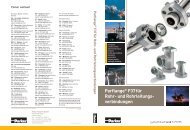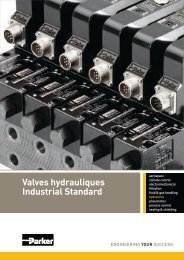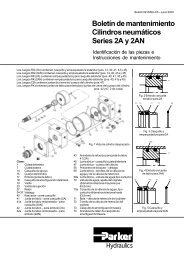Vaporizable Dielectric Fluid Cooling of IGBT Power Semiconductors ...
Vaporizable Dielectric Fluid Cooling of IGBT Power Semiconductors ...
Vaporizable Dielectric Fluid Cooling of IGBT Power Semiconductors ...
You also want an ePaper? Increase the reach of your titles
YUMPU automatically turns print PDFs into web optimized ePapers that Google loves.
this is typically expected to be the case with certain battery<br />
technologies.<br />
Limitations <strong>of</strong> traditional vapor cycle compression systems<br />
are the lack <strong>of</strong> continuous duty compressors with adequate<br />
reliability under continuous duty <strong>of</strong> 50,000 hours, minimum,<br />
compressor size, and the increased complexity in managing the<br />
evaporator temperature and head pressure. In addition, certain<br />
system designs may be limited by concerns for dew point and<br />
condensation in proximity to electronic circuits; high internal<br />
pressures and safety concerns; loss-<strong>of</strong>-coolant requirements<br />
(such as in military aerospace designs); and increased cost.<br />
Specific requirements <strong>of</strong> system design will drive which<br />
thermal management system is selected, each industry segment<br />
is different, and no one concept or technique will be universal.<br />
A critically important secondary objective achieved in a<br />
two-phase liquid system employing liquid cold plates (i.e.,<br />
contact or “touch” heat transfer between the heat source and the<br />
first-level thermal component) is the isothermal or nearisothermal<br />
cold plate mounting surface achieved. To<br />
characterize this in general terms, a typical liquid cold plate for<br />
<strong>IGBT</strong> power semiconductor cooling may exhibit less than 1°C<br />
in temperature variation across a cold plate surface (e.g., 150-<br />
200mm in length) with multiple high heat source components<br />
mounted.<br />
Physical volume and weight reduction are additional<br />
secondary objectives for considering two-phase cooling.<br />
Traditional air-cooled aluminum extruded heat sinks are<br />
extremely common and a relatively inexpensive thermal<br />
management solution. However, use <strong>of</strong> strictly air-cooled<br />
thermal management techniques for higher-power dissipation<br />
modules results in substantial physical volume required to<br />
handle large amounts <strong>of</strong> heat dissipated. The physical volume<br />
required and the costs for required fans, heat sinks, and<br />
electrical bus bars to accommodate required spacing, cabinetry,<br />
and other factors may be reduced by utilizing more efficient<br />
cooling media, such as liquids. Utilizing a liquid cooling<br />
solution enables increased system power density or, as an<br />
alternative design goal, reduction in total physical volume for<br />
the system. While a single-phase liquid system may not<br />
accomplish a total system weight reduction, the efficiencies <strong>of</strong><br />
a two-phase liquid system can be demonstrated to result in both<br />
physical volume and overall weight reduction.<br />
II. SYSTEM CONCEPTS AND THERMAL PERFORMANCE<br />
A. Thermal Performance <strong>of</strong> Refrigerants as Coolants<br />
Use <strong>of</strong> a vaporizable dielectric liquid as a coolant in a<br />
pumped vaporizable dielectric fluid system has been<br />
investigated and developed as a thermal management <strong>of</strong><br />
computing systems with processors dissipating up to 400W<br />
each, in a large enterprise server system. [6, 7]<br />
One suitable fluid is R-134a, a commodity fluid that is<br />
ubiquitous in refrigeration systems for automobiles and many<br />
types <strong>of</strong> commercial and industrial applications. Table 1 shows<br />
a thermal performance comparison <strong>of</strong> R-134a and water.<br />
TABLE I. REFRIGERANTS AS LIQUID COOLANTS<br />
Coolant<br />
(1 gram)<br />
Coolant<br />
Temperature<br />
Increase<br />
Water 5°C (9.0°F)<br />
R-134a<br />
(40°C)<br />
(Isothermal at<br />
40°C*)<br />
Flow Rate<br />
Required to<br />
Dissipate 1kW<br />
2.9 l/min.<br />
(46 gal./hr.)<br />
0.35 l/min.<br />
(5.8 gal./hr.)<br />
Note: * Dependent upon system pressure.<br />
Table 1. Comparison <strong>of</strong> flow rate required to dissipate 1kW <strong>of</strong> power:<br />
Relative performance <strong>of</strong> water and R-134a refrigerant as a coolant.<br />
R-134a refrigerant is available from a large number <strong>of</strong><br />
suppliers, low in cost, and has been well-characterized for<br />
many types <strong>of</strong> refrigeration applications. Important for the<br />
system design engineer, a very large number <strong>of</strong> types <strong>of</strong><br />
tubing, connectors, condensers, manifolds, and other<br />
components have been developed and applied for decades in<br />
R-134-based refrigeration systems. The availability <strong>of</strong> this<br />
large variety <strong>of</strong> system components adds design flexibility;<br />
<strong>of</strong>fers potential cost savings from proven manufacturing<br />
processes; and incorporates proven reliability <strong>of</strong>, for example,<br />
quick disconnect connectors and manifolds manufactured for<br />
decades for commercial refrigeration systems.<br />
Safety considerations are important in electrical system<br />
design. As a dielectric, a system leak results only in<br />
vaporization <strong>of</strong> the fluid, non-toxic in reasonable quantities. In<br />
the event <strong>of</strong> a leak, the R-134a fluid vaporizes without<br />
damaging electronic components.<br />
B. Principal Components<br />
A pumped VDF system has been developed for cooling<br />
power semiconductor devices. A pro<strong>of</strong>-<strong>of</strong>-concept<br />
implementation <strong>of</strong> this cooling system within an electrical drive<br />
system for industrial and power generation applications has<br />
been completed and tested. Cost, cooling performance, and<br />
volume reductions achieved and the net system capacity<br />
increase have been documented. Practical implementation <strong>of</strong><br />
this system concept, replacing air- and water-cooled electrical<br />
drives, has very recently entered production for industrial<br />
electrical drives. [8, 9] Other applications are being examined.<br />
Main components <strong>of</strong> a two-phase dielectric fluid cooling<br />
system are:<br />
a. Liquid cold plate evaporators in parallel or series<br />
for one or multiple heat sources, with manifold<br />
and connectors;<br />
b. Low-flow rate pump(s) designed for use with<br />
dielectric fluids;





